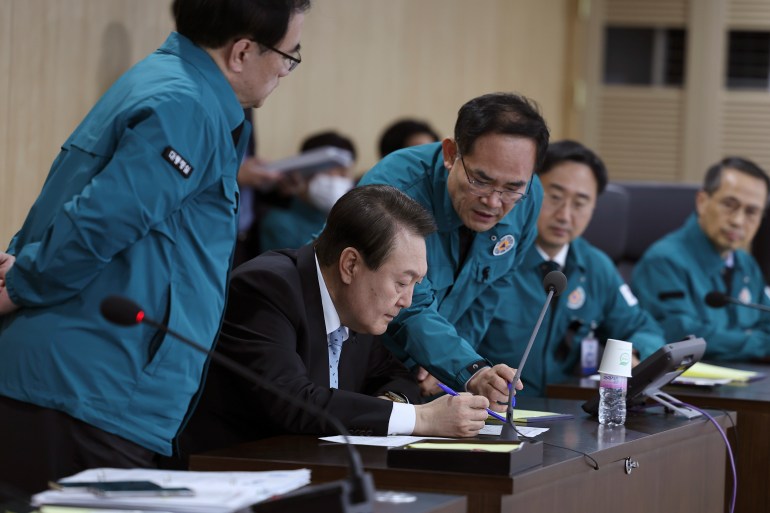N Korean missile lands off S Korea coast, Seoul launches response
Launches follow Pyongyang warning over ongoing military exercises between South Korea and the United States.

A North Korean missile has landed near South Korean waters for the first time, prompting Seoul to respond with its own air-to-ground missiles after residents on an eastern island were told to evacuate.
The North Korean missile, one of at least 23 fired throughout Wednesday, was detected by South Korea’s military and the Japanese coast guard. It landed less than 60km (37 miles) off the South’s coast.
Keep reading
list of 4 itemsNorth Korea fires two ballistic missiles towards Sea of Japan
World ‘holding breath’ over possible N Korea nuclear test: IAEA
US, Japan, S Korea vow response if N Korea tests nuclear bomb
A few hours later South Korea said its warplanes fired three air-to-ground missiles into the sea towards the north of the two countries’ maritime border. Some air routes along the country’s east coast had also been closed to commercial aircraft, the transport ministry said.
“Our military’s response reaffirms our resolve to sternly respond to any provocations (by North Korea) and shows that we are capable of accurately striking our enemy,” South Korea’s Joint Chiefs of Staff (JCS) said of the missiles its aircraft fired, according to the Yonhap News Agency.
Later on Wednesday, North Korea fired about 100 artillery shells into an eastern maritime buffer zone the two Koreas created in 2018 to reduce tensions, according to South Korea’s military. That was followed by six more missiles fired toward the East Sea, also known as the Sea of Japan, and the Yellow Sea, Yonhap reported.
The latest escalation in military activity on the divided peninsula comes after Pyongyang demanded the United States and South Korea stop ongoing large-scale military drills, saying such “military rashness and provocation can be no longer tolerated”.
The JCS said one of the North Korean missiles landed 26km (16 miles) south of the Northern Limit Line, which serves as an unofficial maritime border between the two Koreas; the first time that has happened since the Korean War ended in an armistice in 1953.
The launch was “very unusual and absolutely unacceptable”, the JCS said, adding that it would respond “decisively”.
It was one of three short-range missiles launched from the area around Wonsan on North Korea’s eastern coast at about 8.51am (23:51 GMT), according to the JCS and an air raid warning for the island of Ulleung was issued shortly afterwards.
Imagine watching TV this morning to the sound of an air raid alarm due to North Korean missiles pic.twitter.com/RrizYAlKXY
— Raphael Rashid (@koryodynasty) November 2, 2022
The missile landed 57km (35 miles) from the South Korean city of Sokcho on the east coast, and 167km (104 miles) from Ulleung, with an air raid warning for the island broadcast on national television.
President Yoon Suk-yeol convened a meeting of the National Security Council and condemned the “unprecedented” launches, which took place amid a period of national mourning for the 156 people killed in the Itaewon crowd crush at the weekend.
Sending a missile south of the NLL was “tantamount to territorial intrusion”, he was quoted as saying in a statement following the NSC meeting with his office promising a “swift and firm response” so North Korea “pays the price for provocation”.
“Seoul is justified in staging a proportional response to Pyongyang’s provocation across the de facto maritime border,” Leif-Eric Easley, a professor at Ewha University in Seoul, told Al Jazeera. “But eye-for-an-eye demonstrations of force are unlikely to deter North Korean missile tests and could lead to unintended escalation.”
He suggested the South would be better off imposing costs on Pyongyang by multilaterally tightening sanctions, and pressuring China to lean on North Korea by expanding US-South Korea-Japan security cooperation.
Protest lodged
North Korea has carried out an unprecedented number of weapons tests this year – now more than double the launch record set in 2019 – and there are expectations it may soon resume nuclear testing.
Japan said it had detected two suspected ballistic missiles launched from the North with one flying east and the other southeast.
“North Korea has been repeatedly launching missiles at an unprecedented rate, in new ways that we have not seen before,” Defence Minister Yasukazu Hamada told reporters in Tokyo on Wednesday.
“These actions threaten the peace and stability of Japan, the wider region, as well as the broader international community, and are utterly unacceptable.”

Japan has lodged a protest against the launches via diplomatic channels in Beijing, he added.
Pyongyang argues its weapons are necessary for “self defence” and that recent tests are a warning to Washington and Seoul over joint military drills that it views as an invasion rehearsal.
This week’s exercises, dubbed Vigilant Storm, began on Monday and are some of the two allies’ largest, involving about 240 warplanes from both sides staging mock attacks 24 hours a day.
The White House says such drills are part of the US’s routine training schedule with South Korea.
“We reject the notion that they serve as any sort of provocation. We have made clear that we have no hostile intent towards the DPRK and call on them to engage in serious and sustained diplomacy,” White House National Security Council Spokesperson Adrienne Watson said on Tuesday, using North Korea’s official name, the Democratic People’s Republic of Korea.
“The DPRK continues to not respond. At the same time, we will continue to work closely with our allies and partners to limit the North’s ability to advance its unlawful weapons programmes and threaten regional stability.”